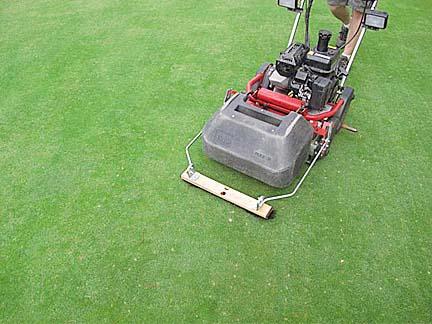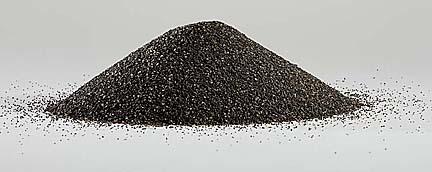 Looking back at his first job in the golf business, Chris Gray admits that he didn't know a bag of fertilizer from a bag of fungicide. But Odie Martin, a retiree who did almost everything at Angel Hill Golf Course in rural Rossville, Ind., did know the difference, and he was partial a granular fertilizer from LebanonTurf named Country Club. The results, Gray says, were exceptional putting conditions on push-up greens that were originally built by former Purdue turfgrass professor William Daniel, Ph.D.
Looking back at his first job in the golf business, Chris Gray admits that he didn't know a bag of fertilizer from a bag of fungicide. But Odie Martin, a retiree who did almost everything at Angel Hill Golf Course in rural Rossville, Ind., did know the difference, and he was partial a granular fertilizer from LebanonTurf named Country Club. The results, Gray says, were exceptional putting conditions on push-up greens that were originally built by former Purdue turfgrass professor William Daniel, Ph.D.Gray, the former superintendent and current marketing manager for LebanonTurf's professional products division, also acknowledges that not much about Country Club has changed since his high school days in the 1980s when he worked at Angel Hill - until now.
LebanonTurf is revitalizing its Country Club line with three new greens-grade granular fertilizers under the Country Club MD badge with a particle Size Guide Number of 80. The three new products are the first of many that eventually will carry the company's time-tested label, not all of which will be fertilizers.
Each of the new Country Club products (12-0-24, 18-0-18, 22-0-16) represents a homogeneous formulation of Meth-Ex, LebanonTurf's proprietary slow-release methylene urea, sea kelp meal and humic acids developed for maximum dispersion (thus the name MD) with minimal watering-in to deliver season-long feeding.
"With today's canopies, whether it be ultradwarf Bermudas, whether it be bentgrasses, everything's gotten tighter. There is less and less canopy space for fertilizer to drop into," Gray said during Lebanon's recent product launch. "It's critical that the initial size of the particle is small enough to accommodate that."
To date, Country Club MD is registered in 46 states, and LebanonTurf will begin officially taking orders Aug. 5.
Kelp meal and humic acids provide the biostimulus that provides the plant with stress protection, so that when the onset of stressful conditions occur it allows the plant to stay healthier longer and recover quicker when stress periods are over, Gray said.
"The stress protection is what sets us apart," Gray said.
With an SGN particle size of 100, the original Country Club line was a good fit for the way putting greens were managed in the 1980s and earlier. But new turf varieties with more densely packed canopies combined with lower heights of cut made smaller particle sizes a necessity. Instead of working their way down through the canopy to where they were needed, those larger particles can be picked up by mowers, golf shoes, golf balls and whatever else happen to track over them.
Other companies, primarily The Andersons, have since taken over the granular fertilizer market with products touting smaller granules that get to where they are needed most - beneath the turf canopy.
"The golf standard right now in the industry obviously is The Andersons' DG technology," Gray said.
"By all of our estimations, they have the lion's share of the market; anywhere from 60 to 70 percent of the greens grade business, and up until that time there wasn't a lot of work being doing done by Lebanon as far as a way to answer that call. We had to find a way to reposition or revitalize that Country Club line.
"Up to this point, the smallest Country Club product was 100 SGN. . . . Initially, we were running into issues with the 100 SGN it wasn't breaking down into small enough particles to get into these tighter canopies.
"It is important for us to have something that was going to allow us to compete in the same marketplace."
In dispersion testing, about 60 percent of the Country Club MD product dispersed with minimal watering-in, with about 50 percent of the material beginning to break down within about six minutes.
Former superintendent Tom Trammel used The Andersons' Contec DG with 75 SGN in preparation for some very high-profile events at the Doral Golf Resort in Miami. In fact, he was so impressed that he now reps for The Andersons since retiring as a superintendent and setting up shop as a turfgrass consultant in Vero Beach, Fla.
"It was the only granular product on the market that wouldn't wash off with the rain, get tracked off or was visible to the golfers," Trammel said.
"Doral has hosted six World Golf Championships, and I was there for all six. The Andersons was part of all of them for those reasons."
A year in the making, the new Country Club products have undergone intensive scientific testing on creeping bentgrass, ultradwarf Bermudagrass and Poa annua by researchers at the University of Illinois, University of Florida and Rutgers University, respectively.
The research phase included an exhaustive fact-finding mission by Tom Fermanian, Ph.D., of Illinois, who took a closer look at the benefits of sea plant extracts and humic acids because so little scientific information on them exists.
According to a survey conducted by Lebanon, about 60 percent of respondents said they recognize the benefits of sea plant extracts. However, few have pulled the trigger to incorporate it into their management program.
The company employed Fermanian to discover the effects of sea plants and humic acids on turf, finding out what they can do and, just as importantly, what they cannot do, Gray said.
According to the findings, kelp meal provides amino acids and aids in the dispersion process, while humic acid, another biostimulant, also helps in dispersion and acts as soil microbial stimulator and organic chelator that helps maximize a plant's systemic properties.
 "Anything it didn't do, we don't make a claim for," Gray said. "We want to be accurate with that. We feel that there is too much information out, and a lot of it is not accurate.
"Anything it didn't do, we don't make a claim for," Gray said. "We want to be accurate with that. We feel that there is too much information out, and a lot of it is not accurate."We knew that in addition to trying to help us get to the goal of achieving the best dispersion possible, now we've got some agronomic benefits we can tout as well. It's a win-win situation that like a lot of things we stumbled upon by accident."
Fermanian also performed a performance study, in which the Country Club MD products were tested head to head against The Andersons DG 17-0-17 at various application rates as well as the 18-3-18 composite version of Country Club. MD and the Andersons product consistently showed little mower pick up and enhanced visual turf quality, according to the study results.
The 22-0-16 version of Country Club MD also was tested in the field on cool- and warm-season grasses on at least 13 golf courses.
Matt Taylor, superintendent of the Riverside Course at Atlanta Athletic Club tested the 22-0-16 Country Club product from May 5-June 1 on the bentgrass greens (007-A1/A4 mix) on the practice facility putting greens at a rate of 0.75 pounds of nitrogen per 1,000 square feet.
Taylor said he was impressed by the quick flush of growth, green color, turf density and increased root growth.
"The overall appearance and healthiness of the greens were the best that I have seen in the six years that I have managed them," Taylor said. "However, due to the large amount of nitrogen applied, the firmness decreased and thatch levels increased quickly."
Research conducted on Country Club MD showed no signs of burn when applied to turf, an attribute Chris Carson confirmed when testing the 22-0-16 on a bent/Poa chipping green Echo Lake Country Club in Westfeld, N.J.
Although applied at the same rate of 0.75 pounds of N per 1,000 square feet, there was no flush of growth at Echo Lake, which Carson attributed to use of Primo. The particle size meant no pick up, but the dark color made it difficult to see during the application process, necessitating use of flags to avoid overlap.
"It did a decent job," Carson said. "(It was) hard to apply, (and showed) good color one month later."
Currently, greens grade fertilizers are the only new products under the Country Club MD umbrella, but plans are for the line to eventually include products with larger SGN for use on tees and fairways, as well as a foliar line. Other potential product entries in the future could include fungicides, herbicides, plant growth regulators and even seed.
"Our overall focus is to make sure that the Country Club brand is a complete line," Gray said. "Country Club MD is only one step, and is the first step toward that overall goal because Country Club MD is not a complete golf line right now. It is a fertilizer line, but it's just granular fertilizer in a bag.
"Our goal (is) trying to be a full line of one-stop shopping. . . . This product, the MD technology, is only the first step in moving forward with this. We think it's an important step.

